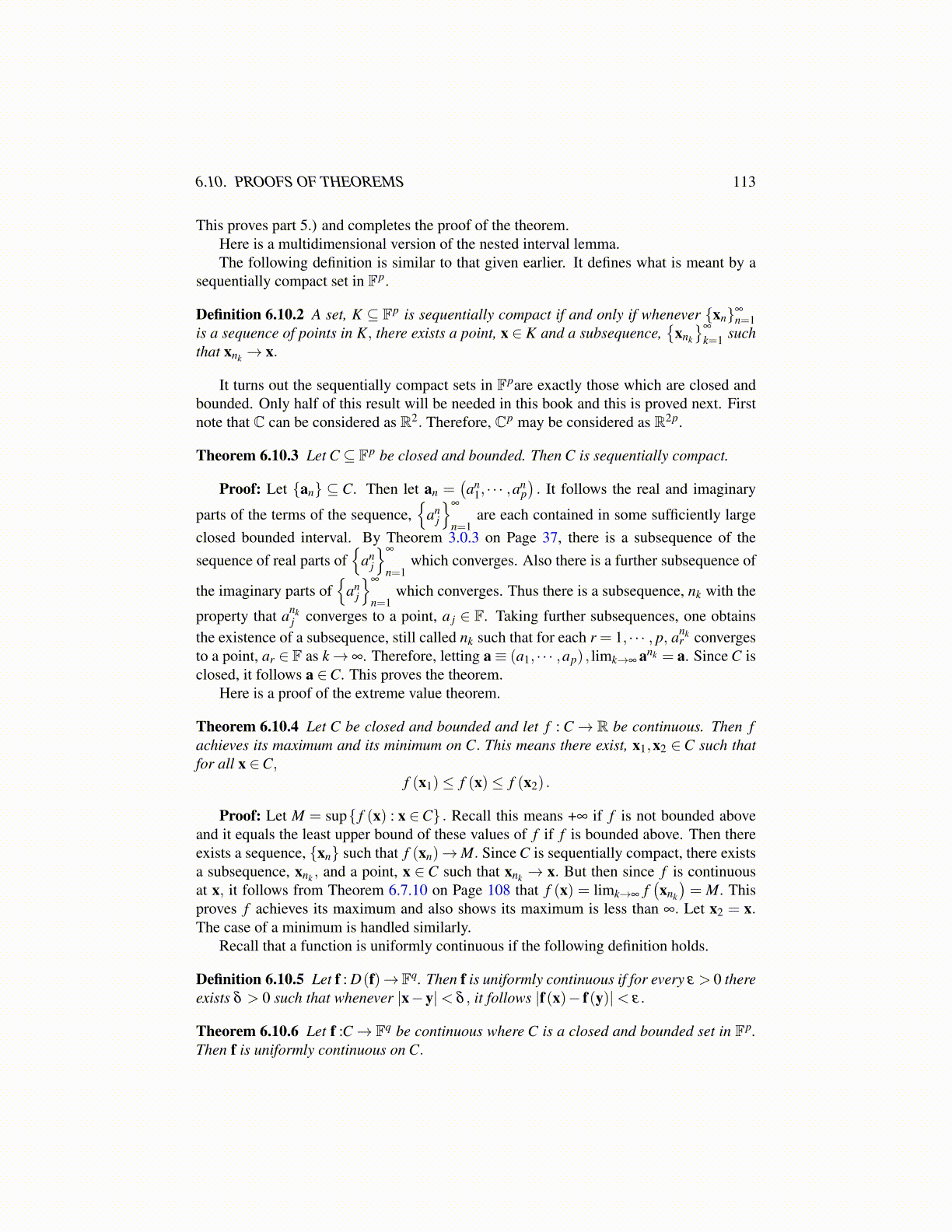
6.10. PROOFS OF THEOREMS 113
This proves part 5.) and completes the proof of the theorem.Here is a multidimensional version of the nested interval lemma.The following definition is similar to that given earlier. It defines what is meant by a
sequentially compact set in Fp.
Definition 6.10.2 A set, K ⊆ Fp is sequentially compact if and only if whenever {xn}∞
n=1is a sequence of points in K, there exists a point, x ∈ K and a subsequence,
{xnk
}∞
k=1 suchthat xnk → x.
It turns out the sequentially compact sets in Fpare exactly those which are closed andbounded. Only half of this result will be needed in this book and this is proved next. Firstnote that C can be considered as R2. Therefore, Cp may be considered as R2p.
Theorem 6.10.3 Let C ⊆ Fp be closed and bounded. Then C is sequentially compact.
Proof: Let {an} ⊆ C. Then let an =(an
1, · · · ,anp). It follows the real and imaginary
parts of the terms of the sequence,{
anj
}∞
n=1are each contained in some sufficiently large
closed bounded interval. By Theorem 3.0.3 on Page 37, there is a subsequence of thesequence of real parts of
{an
j
}∞
n=1which converges. Also there is a further subsequence of
the imaginary parts of{
anj
}∞
n=1which converges. Thus there is a subsequence, nk with the
property that ankj converges to a point, a j ∈ F. Taking further subsequences, one obtains
the existence of a subsequence, still called nk such that for each r = 1, · · · , p, ankr converges
to a point, ar ∈ F as k→ ∞. Therefore, letting a≡ (a1, · · · ,ap) , limk→∞ ank = a. Since C isclosed, it follows a ∈C. This proves the theorem.
Here is a proof of the extreme value theorem.
Theorem 6.10.4 Let C be closed and bounded and let f : C→ R be continuous. Then fachieves its maximum and its minimum on C. This means there exist, x1,x2 ∈C such thatfor all x ∈C,
f (x1)≤ f (x)≤ f (x2) .
Proof: Let M = sup{ f (x) : x ∈C} . Recall this means +∞ if f is not bounded aboveand it equals the least upper bound of these values of f if f is bounded above. Then thereexists a sequence, {xn} such that f (xn)→M. Since C is sequentially compact, there existsa subsequence, xnk , and a point, x ∈ C such that xnk → x. But then since f is continuousat x, it follows from Theorem 6.7.10 on Page 108 that f (x) = limk→∞ f
(xnk
)= M. This
proves f achieves its maximum and also shows its maximum is less than ∞. Let x2 = x.The case of a minimum is handled similarly.
Recall that a function is uniformly continuous if the following definition holds.
Definition 6.10.5 Let f : D(f)→ Fq. Then f is uniformly continuous if for every ε > 0 thereexists δ > 0 such that whenever |x−y|< δ , it follows |f(x)− f(y)|< ε.
Theorem 6.10.6 Let f :C→ Fq be continuous where C is a closed and bounded set in Fp.Then f is uniformly continuous on C.